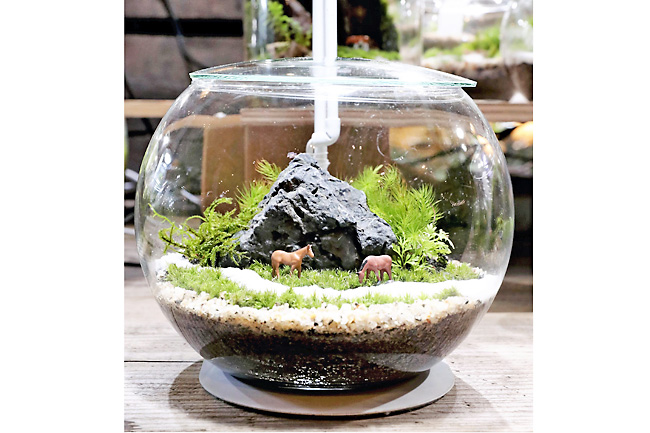Takashi Sakinaga
THE JAPAN NEWS-YOMIURI – The terrarium is one timeless pastime that has thrived amid
the pandemic.
Events focussed on the soothing self-contained gardens have been cropping up across Japan, catering to a renewed appreciation for terrariums as a miniature oasis of calm for the home.
A portmanteau of the Latin ‘terra ‘(earth) and ‘-arium’ (as in aquarium), the terrarium is said to have first taken root in Europe in the 19th Century.
While the horticultural technique can be used to cultivate a wide range of plants, mosses are an easy place to start.
‘Koke terrariums’ (moss terrariums) are a perennial favourite among hobbyists, available at shops and gardening events. Popular moss species include Hinoki-goke (rhizogoniales) and Hosobaokina-goke (leucobryum). In early October, terrarium enthusiasts flocked to Nabolo (Nagoya Botanical Lounge), a pop-up event held at Garage Nagoya, a botanical shop specialising in green interior decor. Eleven vendors led instructional workshops at the event and sold living works of art that evoked pastoral scenes of grazing horses, austere rock gardens with white sand, and roly-poly marimo moss balls.

Moss is an ideal plant for indoor gardens, said Tokyo-based terrarium dealer Feel The Garden, one of the organisers behind Nabolo. It simply requires a spritz of water once a month. No fertiliser needed.
“I’m obsessed with moss,” said Terutaka Onishi, 32, who works at Feel The Garden. “Their fresh little shoots are adorable.”
To make your own terrarium, cover the bottom of a container with substrate – akatsuchi potting soil and sand sterilised at high heat work well – toss in a few larger rocks, and gently plant your moss. Use tweezers to finesse the details. Animal figurines from model railroad kits add a playful finishing touch. One of the workshops at the Nabolo event was led by Toyohide Tanigawa, 37, a terrarium dealer at Mossmile in Toyota, Aichi Prefecture.
“(Terrariums) are perfect for people who enjoy detailed work,” said Tanigawa, who likened designing a terrarium to designing your own world. “You could say it’s a sort of handicraft.”
Other plants like ferns can be used to add further biodiversity to the bottled world.
“Interest in terrariums has been growing during the pandemic, with people spending more time at home,” Tanigawa said. “I hope people will slow down and really nurture their (terrariums).”
Moss should not be exposed to direct sunlight, as it can dry out.
According to head of Feel The Garden Tsuyoshi Kawamoto, moss grows well in LED light.
Store-bought terrariums tend not to be sealed, because a small opening helps regulate the humidity levels and prevent condensation.
He recommends beginners start out with an open terrarium design.
“Mosses grow through photosynthesis,” Kawamoto said. “If they become unruly, you can give them a trim.
“It’s fun to watch the moss thicken and create new layers that transform the scenery.”








